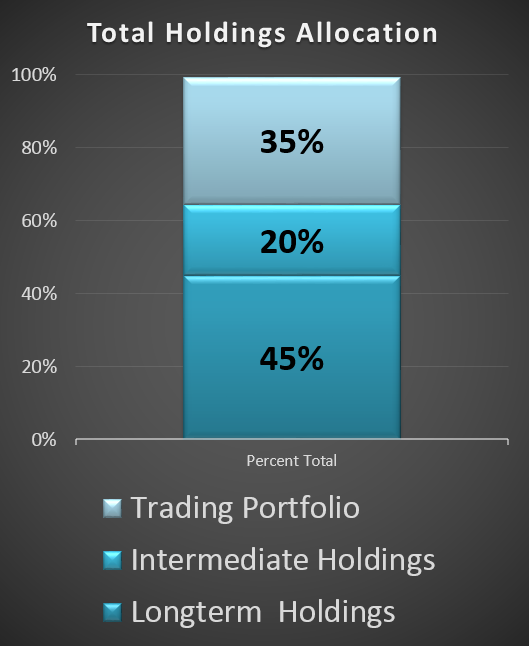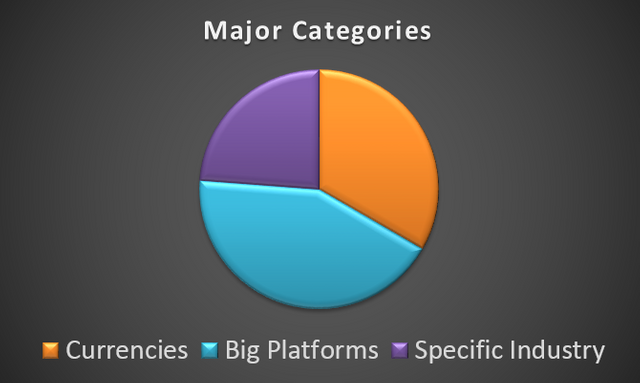Are you an Investor or a Trader? | My Thoughts On Portfolio Set Up
The volatility in cryptocurrencies makes it an attractive market for those that like to day trade or swing trade. It’s not unusual to see increases of 50%, 70% or even 100%+ in just a few days. However, the volatility cuts both ways and the smaller cap names can also drop by large percentages just as quickly.
Not everyone wants to look at charts all day so is there room for those interested in investing for the long term? Yes, absolutely! My portfolio is split into two major portions. I’ll use one part to take advantages of day trades and will be very active with that part of the portfolio. Simultaneously, I’ll keep core positions that I like to accumulate over time and hold for months or longer. This second group is broken into Long-term and Intermediate-Term holdings.
The key is picking the more stable and promising projects for longer-term holds. As shown in the chart below, my trading portfolio can be up to 35% of the total. For some that may be too high and unless you’re comfortable or experienced with trading, I would suggest making it a much smaller percent of your total crypto holdings.
Here is how I define the categories:
Trading Portfolio: Positions held between a few hours to a few days.
Intermediate Holdings: Held for weeks to months.
Long-Term Holdings: Held for months to years.

Picking The Winners
So how does one pick which ones to hold with so many new names popping up all the time? First off, you need to hold some of the market cap leaders as these will also have institutional sponsorship which limits the downside risk some. It’s no surprise but this would include Bitcoin & Ethereum.
You can make room in your portfolio for more speculative names that you think will go up 10X or 100X in a few years but I would suggest that you limit those to just 10-20% of the portfolio. It’s impossible to know which will be the big winners in 2-5 years so you also have to make room for new entrants. For example, Antshares/NEO was not on my radar 4 months ago but I’m now holding it and consider it one of my top five choices.
Long-Term Portfolio
Your intermediate & long-term portfolio should have more than one name in it and I suggest you consider holding at least one cryptocurrency for each of the following three categories:
Currencies, Platforms & Industry Specific Services.

There are hundreds of coins that are really just tokens without a lot of long-term use case. I generally ignore most of the smaller cap names (less than $50M). Look for things like good underlying technology, industry niche, demand or use case, innovation, white paper and road-map, strength of the team, scalability, etc. Avoid the over-hyped and over-pumped small-cap names. Those may be good for shorter to intermediate trades but not long-term holds until they prove themselves more.
These three categories are broad and can certainly be subdivided further but are summarized for simplicity sake.
Let’s look at examples for each one.
Currencies: Simply those whose primary function is to be a digital currency for daily exchanges and transactions. This would include names like Bitcoin, Litecoin, Dash and Monero.
Platforms: This is referring to those that are establishing the infrastructure and ecosystem for other cryptocurrencies to build on top of. The most notable example is Ethereum with all of the ERC-20 tokens and apps being created on its blockchain. Other names to consider are NEO, NEM, IOTA , Stratis and Waves.
Industry Specific Services: Examples include names such as TenX, OmiseGo, Steem, Iconomi, Golem and Siacoin. This category is very broad and includes many subcategories. For example, Sia is specific to distributed cloud storage while TenX is targeting payment processing. The list can go on but these are often tokens that are built on another platform such as Ethereum or NEO. This could also include some ICO’s.
Does This Mean You Should Never Sell?
Even though something may be labeled as “long-term” or “intermediate holding”, it does not mean sell rules go out the window. Even with these, I will never ride something down 60%, 70% or more. You still should have an absolute stop level in place even if you give it a lot of room. Have a plan. This is why studying technical analysis is important even for long term holds because it will help you time your purchases better as well as help you understand key support and resistance levels.
You should also have a plan to sell and take profit eventually. There are many ways to determine this and I recently posted some videos on sell rules. Many of these guidelines can be also applied to longer-term charts such as the daily or weekly ones.
There are certainly many ways to manage a crypto portfolio. If you have a unique or better way, let me know! I'd love to hear your thoughts.
Learn more at https://nodeinvestor.com/training/
Interesting philosophy. Upvoted:Following.
Ooh, you're back? This is exciting. I can upvote your posts again instead of giving you a worthless like on youtube.
Good advice here by the way.
Yes, I will be more active on here now. Appreciate the support!
I watch all of your videos. Thanks for the advice. Keep up the good work